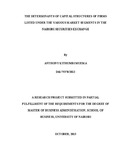| dc.description.abstract | Selection of an optimal capital structure is always a critical issue for every firm. The reason for this is of course, financial risk and tax advantage which are directly influenced by a company’s choice of capital structure. The choice of capital structure is influenced by certain factors. However these factors are still not very clear.
The purpose of this study is to examine the determinants of capital structure across different industries for companies quoted on the Nairobi Securities Exchange. The factors which were tested are; profitability, tangibility of assets, growth of the firm, size of the firm, liquidity and non-debt tax shields. The study demonstrates that the determinants of capital structure are different across the various market segments. The results obtained from the tests indicate that in Agricultural segment, the key determinants of capital structure are profitability and liquidity. The Commercial and Services sector had size of the firm as the only key determinant of capital structure, while profitability was the only factor in Manufacturing segment found to be significantly correlated with leverage. In Construction and allied segment profitability, tangibility of assets, and non-debt tax shields turned out to be the key factors that influence the choice of capital structure. For Energy and Petroleum segment, profitability, tangibility of assets, size of the firm and growth of the firm proved to be significantly correlated to leverage. In Telecommunication, Automobile and Investment segments, no factor showed any significant correlation with leverage. For the combined segments, tangibility of assets and non-debt tax shields were found to be the key determinants of capital structure. In
summary, all the results from the separate regressions and the combined run do indicate that there are disparities in the factors that influence the choice of capital structure. | en |

